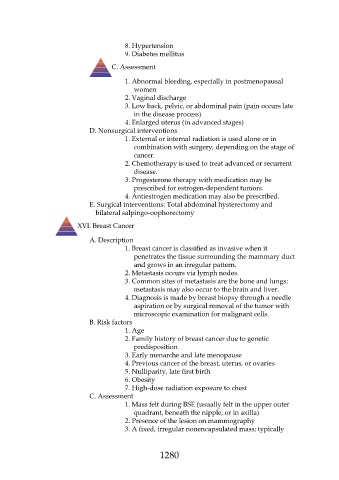Page 1280 - Saunders Comprehensive Review For NCLEX-RN
P. 1280
8. Hypertension
9. Diabetes mellitus
C. Assessment
1. Abnormal bleeding, especially in postmenopausal
women
2. Vaginal discharge
3. Low back, pelvic, or abdominal pain (pain occurs late
in the disease process)
4. Enlarged uterus (in advanced stages)
D. Nonsurgical interventions
1. External or internal radiation is used alone or in
combination with surgery, depending on the stage of
cancer.
2. Chemotherapy is used to treat advanced or recurrent
disease.
3. Progesterone therapy with medication may be
prescribed for estrogen-dependent tumors.
4. Antiestrogen medication may also be prescribed.
E. Surgical interventions: Total abdominal hysterectomy and
bilateral salpingo-oophorectomy
XVI. Breast Cancer
A. Description
1. Breast cancer is classified as invasive when it
penetrates the tissue surrounding the mammary duct
and grows in an irregular pattern.
2. Metastasis occurs via lymph nodes.
3. Common sites of metastasis are the bone and lungs;
metastasis may also occur to the brain and liver.
4. Diagnosis is made by breast biopsy through a needle
aspiration or by surgical removal of the tumor with
microscopic examination for malignant cells.
B. Risk factors
1. Age
2. Family history of breast cancer due to genetic
predisposition
3. Early menarche and late menopause
4. Previous cancer of the breast, uterus, or ovaries
5. Nulliparity, late first birth
6. Obesity
7. High-dose radiation exposure to chest
C. Assessment
1. Mass felt during BSE (usually felt in the upper outer
quadrant, beneath the nipple, or in axilla)
2. Presence of the lesion on mammography
3. A fixed, irregular nonencapsulated mass; typically
1280

